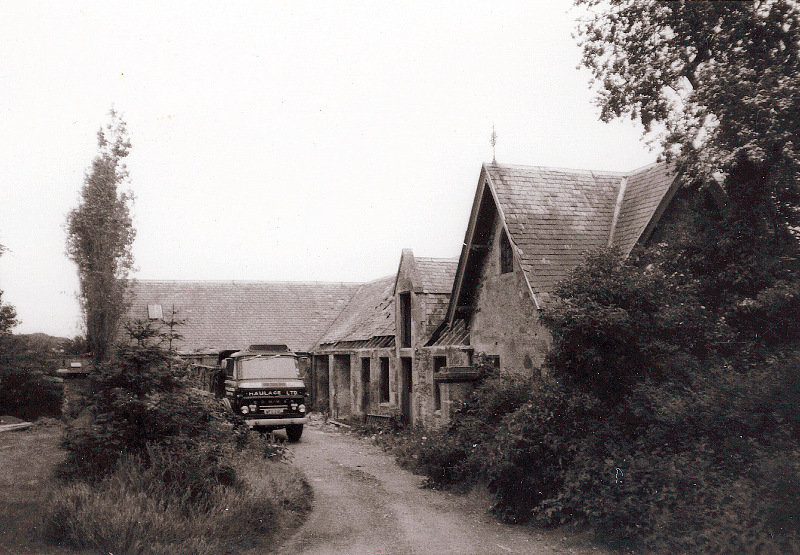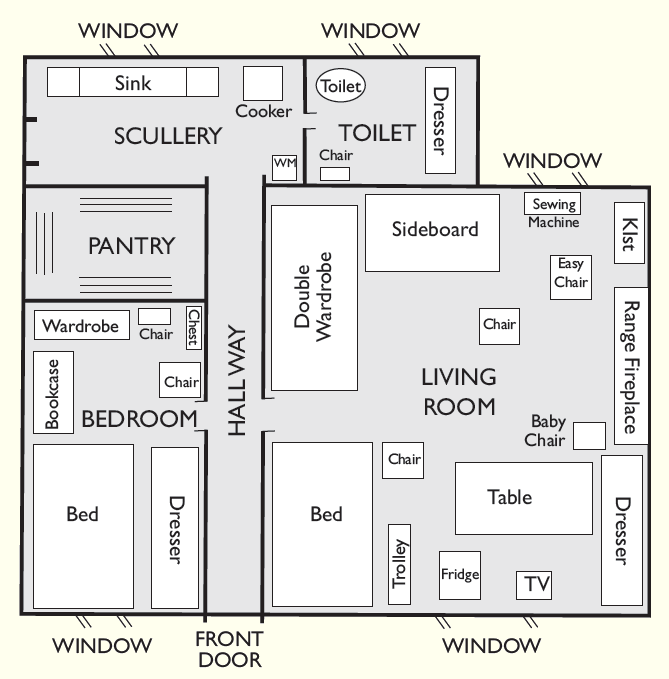Homes | Utilities | Shops & Services
Housing was confined largely to the two main settlements, the village of Macmerry, and a smaller hamlet at Gladsmuir.
Macmerry contains an older row of stone-built houses along the main road, but most of the houses were built between the 1930s and the 1980s by the council. As a result of the governments ‘ right to buy’ policy introduced in the 1980s, many were bought by their tenants; by 2000, about one third of the houses were privately owned.
After the war the village of Macmerry began to expand. Prefabs arrived on the backs of lorries in the late 1940s, and twelve of them were erected in Merryfield Avenue (these were demolished around 1967/8). The Orlit homes in Whiteloch Road and Robin’s Neuk were constructed at about the same time. The houses in Brierbush were built in the 1950s and those in Robin’s Neuk in 1953. Briarbush Road was built up between 1954 and 1973, and Briarbush Crescent in 1973. Annfield Court (SSHA) and Westbank Gardens were built in 1977. Reid Housing built ten sheltered houses in the late 1980s, and there was some private house building to the north of the main street in the 1990s. Most of these were low-rise one or two storey houses, either semi-detached or four in a block or terraced.

Gladsmuir Coach House stables before conversion, 1970s (Jean Shirlaw)
The local authority had built 18 houses in Gladsmuir (ten pre-war at Lammermuir, and eight post-war at Lamington Road), but by 2000 nearly half of these had been sold into private ownership.
The small settlements at Samuelston and Penston both declined over the period to clusters of farm cottages, some of them derelict. There was some renovation and extension of cottages into family homes, especially at Samuelston, in the 1990s through a private developer. At Penston, the former inn was developed and extended into a large private home, but many of the cottages and farm buildings remained unoccupied and semi-derelict at the end of the period. In the rural areas there was some conversion of former agricultural buildings into private homes.

Cottage at Penston (Fiona Dobson)
A rural home at Penston Gardens:
The cottage was built in 1676. It was occupied by the Dobson family from 1890-1997. The walls of the cottage are three feet thick. Originally earthen floors, they are now either stone or floorboarded. The original red pantiled roof was replaced using wooden Canadian Shingle tiles in 1949 – in the years after the second world war, materials were in short supply, and therefore the choice of tile was based on availability. The wooden tiles are at present still on the roof, although in a very poor condition. A scullery and toilet were added to the original building in 1930 with cold running water. Hot water was added in 1942, and electricity in 1956. The fire, a Lothian Range, was fitted in December 1940 replacing an existing smaller range. The range fire is the only source of heating for the house and water.
Entering the house by the back door leads directly into a small scullery with a lino tile covered stone floor. Underneath the window is a porcelain sink with draining boards on either side. Next to the sink is an electric cooker. Against the opposite wall is a twin tub washing machine. Leading off the scullery is the toilet, comprising toilet pan and wooden dresser used for storage. A door leads off the scullery into a hallway, stone floored, carpeted with rugs. On the right is a shelved pantry concealed by a curtain for storing food and utensils. Next to the pantry is the bedroom. A square room furnished with a double bed, wardrobe, two chests, a large dresser, bookcase and chair. The wooden floorboards are carpeted. There is a double window on the south-facing wall. The living room is square with a single window facing north and a double window facing south. The fire range is situated opposite the entrance door on the east wall.
The living room doubles as a bedroom and is furnished accordingly with a double bed in the corner to the right of the door, trolley beside bed. The TV and fridge are placed underneath the double window; a large old-fashioned dresser is next to the fire range with a wooden four leg table in front. Chairs are around the table on two sides only. An easy chair is to the right of the fire (next to dresser). A kist (doubles as seat) sits to the left of the fire, in front of a wall cupboard. A treadle sewing machine sits underneath the single window with an easy chair in front. A high-backed sideboard is against the wall to the left of the single window. A large double wardrobe is against the wall to the left of the door. The rooms are very cluttered with the furniture generally tightly packed. Lack of storage space means belongings are stacked in piles all around.
Fiona Dobson
Utilities
Mains electricity and a public water supply have been available throughout this period. Mains drainage is supplied in the larger settlements, but properties in the rural areas rely on septic tanks. Mains gas is available in Macmerry, but not elsewhere in the parish.
Both terrestrial and satellite TV are available. Several mobile phone masts were constructed beside the new roadworks, so reception in the area is normally quite good. The main streets of Gladsmuir and Macmerry are lit.
The council provides regular rubbish collections throughout the parish. There is also a council-run waste disposal site at the rear of the Macmerry Industrial Estate, where members of the public can deposit their own rubbish.
Shops & Services
The small number of shops in the parish served the local area and immediate surroundings only, and by 2000 had been reduced to one general store in Macmerry.
Macmerry was never a major retail centre, and by 2000 the only remaining retail outlet was a Spar convenience store in the main street. Until the 1980s this included a post office, but this was closed and relocated in separate premises beside the village hall. Macmerry garage in the main street is used as a workshop for repairs.

Macmerry village shop and Post Office, 1950s
A public house called the Robin’s Neuk was built at the western end of Macmerry in 1968, and was later renamed the Country Inn. It closed in 2000. The Miners’ Welfare Institute and the bowling club were then the only licensed premises in the village.
In Gladsmuir village there was a post office run by Mrs G. Anderson from the 1940s until the 1960s, firstly in a house in Brickrow, and then in a house at the joiner’s shop. Mrs Robson then took over the post office, and it was sited in her home at the old school house until 1975, when it closed.
There has been a garage on the site of the original blacksmith’s shop in Gladsmuir since the 1930s. It changed hands a number of times, but in 2000, continued to sell petrol and undertake repairs and MOTs etc.
A joinery business has operated in Gladsmuir on part of the old Lamington estate since the early 18th century. When the estate was sold in the 1950s, the tenant George Anderson & Sons carried on the business, and the same family still ran the business in 2000. In the 1970s the joiner’s shop, which fronted the A1 road, was converted into a dwelling house and the joinery work carried out in premises to the rear of the building.
James Smith ran a blacksmith‘s business in Gladsmuir until he retired early in the 1990s when the business closed. The work was varied – agricultural repairs, servicing lawnmowers, and all kinds of metalwork, railings, chain link fencing and gates were made. The bulk of the work was for the local council, but ornamental wrought iron gates were also made for Morham churchyard.
In the early part of the period, the parish was served by a number of mobile shops and delivery services. GE Livingstone (from Macmerry) had an ironmongery van, which came to Gladsmuir and the surrounding farms from the late 1940s until the early 1960s; the van was specially adapted to carry a tank containing paraffin for customers’ paraffin lamps and heaters.
There was a fish van from Port Seton, a Co-op van and a butcher’s van from Haddington. Between the 1950s and 1970s, a grocer from Longniddry delivered three times a week if requested. Milk was delivered by the Co-op and the Crown Dairy from Haddington, and newspapers could be delivered from the post office in Macmerry.
By 2000 only a fruit and vegetable van, and a fish van, were still operating.
A mobile library run by the council served both Macmerry and Gladsmuir.